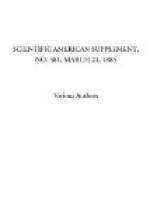Another economy claimed for this engine is in the use of oil. The cranks and connecting rods work in a closed chamber, the lower part of which is filled with oil and water. The oil floats in a layer on the surface of the water, and at every revolution is splashed all over the working parts, including the interior of the cylinder, which it reaches through holes in the piston. The oil is maintained exactly at one level by a very ingenious arrangement. The bottom of the crank chamber communicates through a hole, C, with an outer box, which receives the water deposited by the exhaust steam. The level of this water is exactly determined by an overflow hole, B, which allows all excess above that level to pass into an elbow of the exhaust pipe, out of which it is licked by the passing steam and carried away. Thus, as the oil is gradually used the pressure of the water in the other leg of the hydrostatic balance raises the level of the remaining portion. When a fresh supply of oil is poured into the box, it forces out some of the water and descends very nearly to the level of the hole, B.
The engine is made with either one or two cylinders, and is, of course, single-acting. The pistons and connecting rods are of forged steel and phosphor-bronze. The following is a list of their sizes:
Single Engines. ----------------------------------------------------------- Brake | | | | | Horsepower| Bore of | Revolutions| | | at 62 lb.| Cylinder. | per minute.| Height. |Floor Space.| Boiler | | | | | Pressure. | | | | | ----------|-----------|------------|---------|------------- | in. | | in. | in. in. | 21/4 | 4 | 1,100 | 26 | 14 by 14 | 31/2 | 5 | 1,000 | 28 | 14 " 15 | 6 | 61/2 | 800 | 30 | 16 " 16 | 10 | 8 | 700 | 32 | 18 " 18 | -----------------------------------------------------------<
/pre>Double Engines. ----------------------------------------------------------- Brake | | | | | Horsepower| Bore of | Revolutions| | | at 62 lb.| Cylinder. | per minute.| Height. |Floor Space.| Boiler | | | | | Pressure. | | | | | ----------|-----------|------------|---------|------------- | in. | | in. | in. in. | 41/2 | 4 | 1,100 | 26 | 14 by 20 | 71/4 | 5 | 1,000 | 28 | 14 " 20 | 12 | 61/2 | 800 | 30 | 16 " 26 | 20 | 8 | 700 | 32 | 18 " 32 | -----------------------------------------------------------<
/pre>The manufacturer is Mr. F.D. Bumstead, Hednesford,
Staffordshire.—Engineering.




